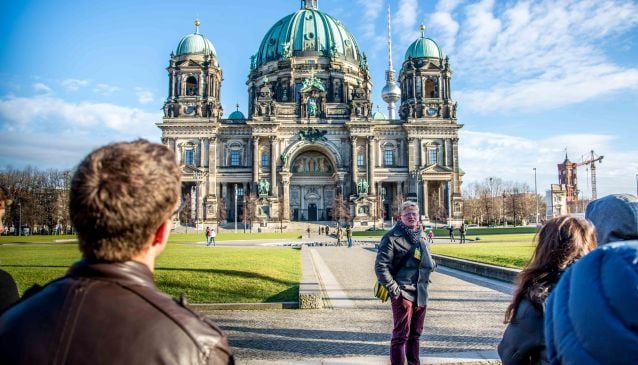Berlin: Karl-Marx-Allee Tour of Life and Architecture in GDR
9 Reviews
Culture & history
Deals & Discounts
Wheelchair accessible
Neighborhood tours
Landmarks & monuments
Tours
Guided tours
Sightseeing
Communist history
Architecture
Private tours
Educational activities
Experience the stunning architecture and awe-inspiring legacy of Germany's first socialist street. Hear the stories of the struggles of East Berliners and uncover the realities of socialist ideology.
Highlights
- Discover how the Cold War ideology shaped Berlin's architecture
- Admire the most ambitious building project in former East Berlin
- Learn more about the East German uprising of 1953
- Uncover the truth about surveillance and suppression by the Stasi police
- See the filming locations of The Lives of Others and The Queen's Gambit
Description
The first socialist street in Germany is sure to impress – one cannot help but feel small walking past the grand housing blocks built in the so-called socialist classicism style. Intended as the main project of the East German national reconstruction programme after WWII, the street emerged from the ruins with the help of thousands of volunteers working day and night. But the building of the street almost cost the young East Germany its very existence. In June 1953, disgruntled workers started a mass uprising that almost toppled the socialist government.
The history of the street stretches further back than the majestic buildings from the 1950s would suggest. The modernist architecture from the immediate post-WWII years reminds one of the utopian urbanist ideas that were born in the ashes of destroyed Berlin. Later on, these buildings were intentionally hidden away from passersby by fast-growing poplar trees. The new East German regime rejected the style and had a radically different idea of what socialist living meant.
The street boasted the best East Berlin had to offer – cafes, restaurants and well-stocked shops, creating an image of idyllic life and affluence in socialism. Though beyond the perfect facade, the reality of the surveillance state remained well hidden. The wiretaps in the flats and the listening stations in the attics used by the East German secret police were not meant to be seen.
Left in a state of disrepair and increasingly looking like an odd curiosity from the past, this street seemed to disappear into oblivion after the fall of the Wall. But nothing is constant in Berlin, and it did not take very long for this street to attract the attention of real estate agents in a city with a housing crisis. While no longer a boulevard for socialist parades, the former Stalinallee is now a stage for protests of the local community against gentrification and the rise in living costs.
Includes
Guide
Easy cancellation
Cancel up to 24 hours in advance for a full refund

